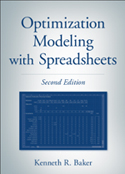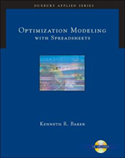About the Book
INTRODUCTION
This is an introductory textbook on optimization—that is, on mathematical programming—intended for undergraduates and graduate students in management or engineering. The principal coverage includes linear programming, nonlinear programming, integer programming and heuristic programming. The emphasis is on model building using Excel.
The emphasis on model building (rather than algorithms) is one of the features that makes this book distinctive. Most textbooks on optimization devote more space to algorithmic details than to formulation principles. These days, however, it is not necessary to know a great deal about algorithms in order to apply optimization tools, especially when relying on the spreadsheet as a solution platform.
The emphasis on spreadsheets is another feature that makes this book distinctive. Few textbooks devoted to optimization pay much attention to spreadsheet implementation, and most books that emphasize model building with spreadsheets cover many topics other than optimization.
The third edition largely follows the topic coverage of the previous edition, with one important change: the presentation is organized around the use of Excel’s Solver. Students using this book can take advantage of even more powerful software packages (Analytic Solver Platform and OpenSolver) by using the material in the online appendices. For the instructor who wants students to be working on one of these platforms, the book provides sufficient information to get started and to learn the user interface. However, students need access to no software other than Excel in order to follow the coverage in the book.
Table of Contents
Chapter 1 Introduction to Spreadsheet Models for Optimization
Chapter 2 Linear Programming: Allocation, Covering and Blending Models
Chapter 3 Linear Programming: Network Models
Chapter 4 Sensitivity Analysis in Linear Programs
Chapter 5 Linear Programming: Data Envelopment Analysis
Chapter 6 Integer Programming: Binary Choice Models
Chapter 7 Integer Programming: Logical Constraints
Chapter 8 Nonlinear Programming
Chapter 9 Heuristic Solutions with the Evolutionary Solver
Appendix 1 Supplemental Files and Software
Appendix 2 Graphical Methods for Linear Programming
Appendix 3 The Simplex Method
Appendix 4 Using Analytic Solver Platform for Education (online)
Appendix 5 Using OpenSolver (online)
The detailed table of contents can be found here (pdf file)
Errata
Click here (Word file)
Previous Editions
Second Edition (John Wiley & Sons, 2011). Supplementary website.

First Edition (Duxbury Press, 2006)

Author
Ken Baker
Tuck School of Business
Hanover, NH 03755, USA
603-646-2064
Editor
Susanne Steitz-Filler
John Wiley & Sons
111 River St., Hoboken, NJ 07030
201-748-6507